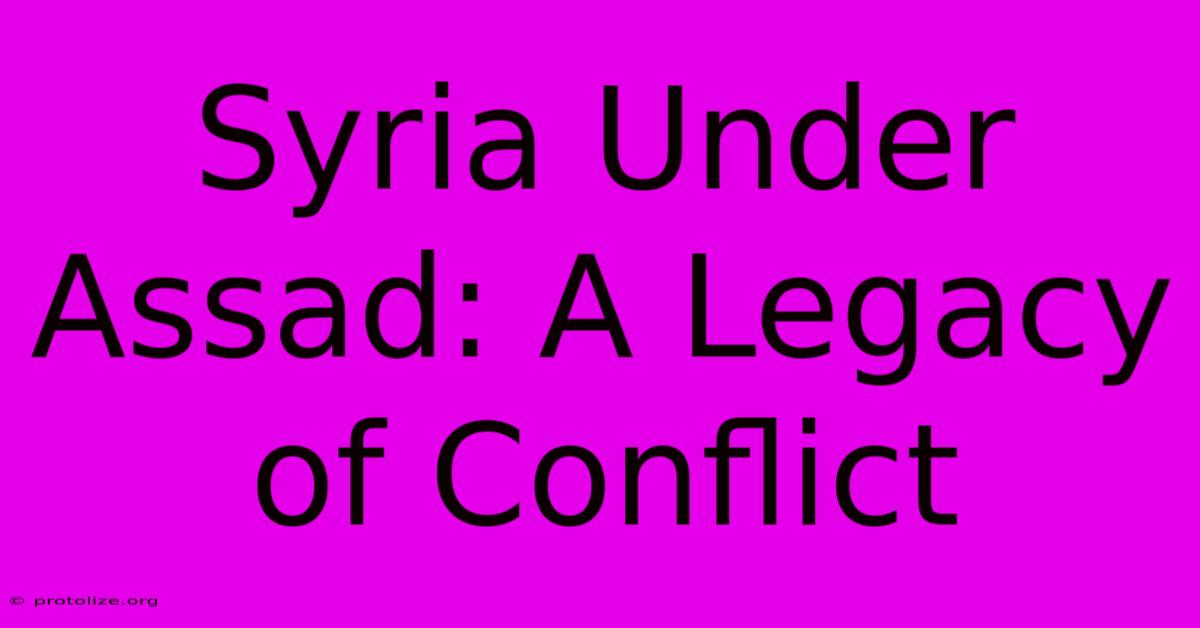Syria Under Assad: A Legacy Of Conflict

Discover more detailed and exciting information on our website. Click the link below to start your adventure: Visit Best Website mr.cleine.com. Don't miss out!
Table of Contents
Syria Under Assad: A Legacy of Conflict
Syria, a nation steeped in history and burdened by conflict, has lived under the Assad family's authoritarian rule for over five decades. This reign, marked by brutal crackdowns, devastating wars, and persistent humanitarian crises, has profoundly shaped the country's trajectory and continues to resonate globally. Understanding the Assad legacy requires examining its key phases, the multifaceted nature of the conflict, and the lasting consequences for the Syrian people and the wider region.
The Rise and Consolidation of Assad Power
The Assad dynasty's grip on power began with Hafez al-Assad's seizure of control in a 1970 coup. His rule, characterized by a strongman approach, centralized power within the Alawite minority sect, a marginalized group within predominantly Sunni Syria. This sectarian power imbalance fueled resentment and laid the groundwork for future unrest. Hafez al-Assad’s regime utilized a sophisticated system of surveillance, repression, and propaganda to maintain control, ruthlessly suppressing dissent and eliminating political opposition.
The Ba'ath Party's Dominance:
The Ba'ath Party, a socialist Arab nationalist party, served as the cornerstone of Assad's authority. It enforced strict control over all aspects of Syrian life, from the economy to the media. This monolithic structure stifled any form of opposition, creating a climate of fear and limiting political participation to a select few.
Bashar al-Assad's Inheritance and the Syrian Civil War
Bashar al-Assad inherited the presidency upon his father's death in 2000. Initially, there were hopes for reform, but these quickly faded. The regime maintained its authoritarian structure, resisting calls for democratization and political liberalization. This repression, coupled with widespread poverty, corruption, and social inequalities, created fertile ground for the uprising that erupted in 2011.
The Arab Spring and the Syrian Uprising:
Inspired by the Arab Spring uprisings, protests began in Syria, demanding political and social reforms. The Assad regime responded with brutal force, unleashing the military and security forces against peaceful demonstrators. This violent crackdown ignited a full-blown civil war, drawing in regional and international actors.
The Complexities of the Conflict:
The Syrian Civil War quickly evolved into a multifaceted conflict, involving a multitude of actors with diverse agendas. These included:
- The Syrian government: Fighting to maintain its grip on power.
- Rebel groups: A fragmented opposition encompassing moderate factions, Islamist groups, and extremist organizations like ISIS.
- Foreign powers: Regional rivals like Iran, Saudi Arabia, and Turkey, as well as global powers such as the United States and Russia, intervened, supporting different factions and pursuing their own geopolitical interests.
The conflict was marked by widespread human rights abuses, including the use of chemical weapons, indiscriminate bombings of civilian areas, and the systematic targeting of religious and ethnic minorities. The resulting humanitarian catastrophe led to millions of refugees and internally displaced persons, destabilizing neighboring countries and causing a global refugee crisis.
The Lasting Impact of the Assad Regime
The Syrian conflict has left an enduring legacy of destruction and suffering. Millions have been killed or displaced, the country's infrastructure has been devastated, and its social fabric torn apart. The Assad regime, despite suffering significant losses, has managed to retain control over much of the country with the crucial support of Russia and Iran.
The Humanitarian Crisis:
The ongoing humanitarian crisis remains dire, with millions in need of food, water, shelter, and medical care. The international community's response has been inadequate, failing to address the scale of the crisis effectively.
The Geopolitical Implications:
The Syrian Civil War has profoundly reshaped the geopolitical landscape of the Middle East, altering the regional balance of power and contributing to broader instability. The involvement of foreign powers has further complicated the conflict, making a lasting solution elusive.
Conclusion: A Path Forward?
The future of Syria under Assad remains uncertain. While the regime has consolidated its control over significant parts of the country, the underlying issues that fueled the conflict – authoritarianism, sectarian divisions, and widespread poverty – persist. Achieving a lasting peace requires addressing these root causes, promoting reconciliation, and ensuring accountability for the atrocities committed during the war. The international community must continue to press for a political solution that prioritizes the needs of the Syrian people and addresses the long-term challenges facing the nation. Without such a concerted effort, the legacy of conflict in Syria will continue to cast a long shadow.

Thank you for visiting our website wich cover about Syria Under Assad: A Legacy Of Conflict. We hope the information provided has been useful to you. Feel free to contact us if you have any questions or need further assistance. See you next time and dont miss to bookmark.
Featured Posts
-
Liverpool Loan Watch Weekend Action
Dec 09, 2024
-
Oregon Claims Big Ten Crown
Dec 09, 2024
-
Nate Tice Critiques Bears Effort
Dec 09, 2024
-
Crm Agency London
Dec 09, 2024
-
Crm Pricing
Dec 09, 2024
